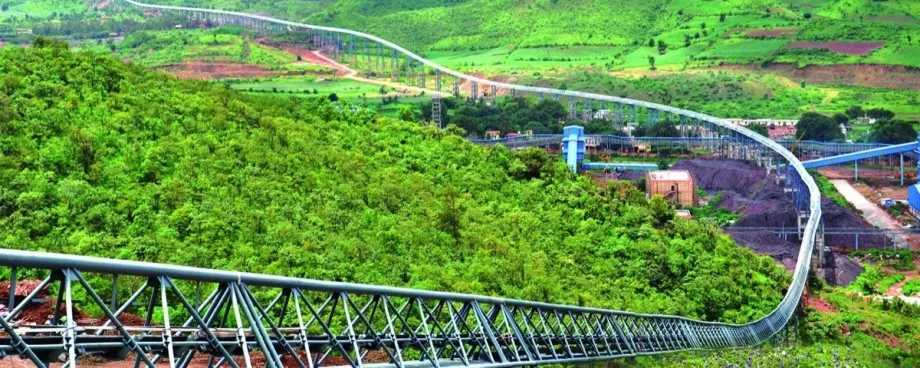Drive Analysis and Torque arm Arrangement
The conveyor has two 800 kW tail drives that is controlled by VSD/VFD; the total drive power available is 1600 kW. The drives can start and stop the conveyor under all load conditions. See the summary in Table 3 of the required power consumption at different loading capacities.
| Load condition | 1 E | 2 FL | 3 FL | 4 FL | 5 FL | 6 FL |
|---|---|---|---|---|---|---|
| Capacity [%] | 0 |
20 |
50 |
70 |
100 | 120 |
| Capacity [tph] | 0 | 400 | 1000 | 1400 | 2000 | 2400 |
| Idler friction [kN] | 4.4 | 5.0 | 5.9 | 6.5 | 7.4 | 8.0 |
| Belt flex [kN] | 33.4 | 33.4 | 33.4 | 33.4 | 33.4 | 33.4 |
| Material flex [kN] | 0.0 | 10.6 | 26.5 | 37.1 | 53.1 | 63.7 |
| Pulley resist. [kN] | 0.0 | -39.5 | -98.7 | -138.2 | -197.4 | -236.9 |
| Material lift [kN] | 1.5 | 1.5 | 1.5 | 1.5 | 1.5 | 1.5 |
| Misc. [kN] | 3.2 | 3.2 | 3.2 | 3.2 | 3.2 | 3.2 |
| Effective tension [kN] | 42.6 | 14.3 | -28.1 | -56.4 | -98.8 | -127.1 |
| Abs. power [kW] | 255.4 | 85.7 | -168.7 | -338.4 | -592.9 | -762.5 |

Table 4 provides a summary of the power demand during the different steady state conditions at different belt loadings.
| Power demand | Empty | Fully loaded | Declines loaded | Inclines loaded |
|---|---|---|---|---|
| Absorbed or regen. [kW] | 255 | -593 | -1245 | 900 |
| Demand power [kW] | 314 | 730 | 1533 | 1108 |
| Demand / installed [%] | 20 | 46 | 96 | 69 |
The torque arm location of the drive base plates was also analysed considering all different belt tensions and all possible operating conditions. This data provided the best possible location for the torque arm location.

Low Speed Brake System
This belt conveyor, being a downhill system, is equipped with a tail brake system mounted on the tail drive pulley. There are two brake disks selected each with a double caliper having a brake rating of 65.2 kNm each. (Total torque available is between 130.4 kNm and 260.8 kNm).
Two control systems are provided, one being digital and the other proportional to stop the conveyor. On each disk, one caliper acts in a digital manner, on/off with quick response and one caliper acts proportionally with a control pressure to regulate the additional braking torque.
The sequence of brake operation can be varied according to the load conditions on the conveyor belt.
When the conveyor is in a regenerative condition the “digital, on/off” brake calipers are applied first, utilising the fast response of this circuit to limit the accelerations that are been generated. Subsequently the proportional circuit would be brought into play to control the deceleration of the conveyor belt.

If the drive torque is positive, or only slightly regenerative, the proportional brake calipers would be first applied to control the deceleration of the conveyor. The required brake torque is determined by the value of the torque from the VFD. If the torque is too high for proportional braking for a controlled stop in the right time, then the digital calipers would be applied at the same time that the proportional calipers reduce to a low (10%) value to be able to resume the complete control functionality.


















